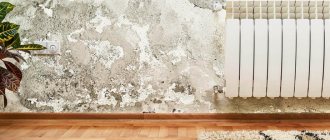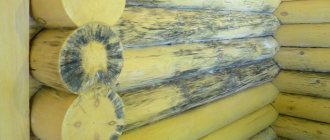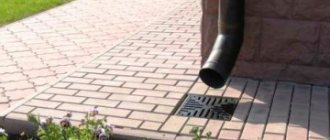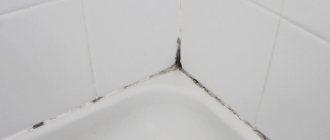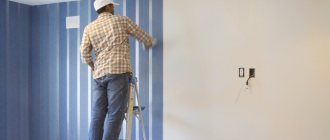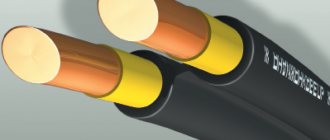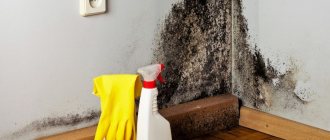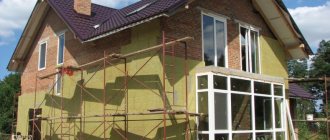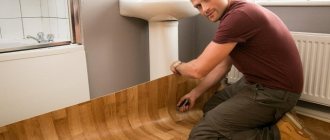Protecting the surfaces of residential premises from mold is a mandatory condition for their finishing and operation; failure to do this stage is literally dangerous for the health and condition of building structures. A primer against fungus and mold is used in the construction and decoration of wooden structures, the preparation of any type of base before finishing, the need to clean surfaces from developed colonies of pathogenic microorganisms and a number of other tasks. With the right approach, its composition, purpose, method of application and other performance characteristics are taken into account along with the type of surfaces being treated and their operating conditions.
Why is mold dangerous?
Mold fungus is a living organism that produces substances that are hazardous to human health. If a favorable environment is created, mold spores begin to quickly spread and destroy surfaces.
Living in a room where there is mold has a negative impact on immunity and productivity. Fungal spores are allergens that can penetrate the human respiratory system through airborne droplets. As a result, unpleasant allergic reactions occur.
Getting rid of mold is quite difficult. Even if you clean the surface of it, it will not improve the situation. Its spores penetrate deep into the material and germinate again after a certain time. Therefore, an antifungal composition that penetrates deep into the material is required.
It is much easier to prevent the spread of mold during construction or renovation. To do this, the surface is treated with protective compounds.
Prevention measures
Anti-fungal primer for walls is the main way to avoid the spread of mold. Additionally, it is necessary to exclude conditions that contribute to its appearance. Additional preventative measures will help protect your premises from fungus:
- Monitor the condition of water supply systems in order to eliminate the increase in humidity in a timely manner.
- During construction, comply with the requirements regarding hydro- and thermal insulation.
- Carefully seal the joints between parts of the supporting structures.
- Equip high-quality ventilation, especially in kitchens, bathrooms, verandas and other similar rooms.
- If bulky pieces of furniture are located close to the walls, you need to change the layout.
- Ventilate the room periodically.
- Install heating in the house.
- Repair the water supply system in a timely manner.
- Use anti-fungus and mold products.
Mold begins to actively spread in warm conditions if there is high humidity. If such conditions are created in a room, then measures must be taken to eliminate them.
On video: how to prevent mold from reoccurring.
Specifics of concrete
Concrete is a material that is quite susceptible to the effects of various biodestroyers, which act like toxins and chemicals, destroying the structure of the structure from the inside and outside. Spores easily attach to the base, multiply and develop on it, and penetrate inside the structure. Contaminated concrete is difficult to process and is dangerous for people. And ordinary cleaning of the top layer is not enough here - if infection has already occurred, you need to urgently use special means.
The main factors contributing to infection:
- High humidity levels
- Unheated building with average temperature (no severe frost or heat)
- Rooms where wet things are regularly dried
- Plumbing that is incorrectly installed or has become unusable, resulting in regular leaks
- A large number of indoor plants that increase air humidity
- Lack of ventilation system in bathrooms
- Volumetric furniture located too close to the walls
To avoid problems, concrete impregnation should be carried out during the installation and operation of structures.
Benefits of primer
Antibacterial primer contains fungicides - special substances that can destroy harmful microorganisms. Additionally, priming performs the following tasks:
- reduces the consumption of subsequent finishing materials (paint, plaster, wallpaper, etc.);
- the quality of finishing is improved;
- eliminates the occurrence of cracks after painting;
- increases the durability of the finish;
- neutralizes unpleasant odors during painting;
- creates a coating that can repel moisture;
- prevents the processes of decay of the material.
After applying the antifungal primer, further surface finishing is performed. This includes puttying, applying plaster, paint, waterproofing materials, wallpapering, and installing facing tiles.
Priming is used to treat walls, floors and ceilings of a room. It is especially important to protect external walls that are exposed to precipitation from fungus.
External wall treatment
This type of work should be trusted only to effective products with the most powerful effects and hydrophobic properties. Therefore, you should think about safety in advance by preparing a protective suit, goggles, gloves, and a respirator.
First, stains are mechanically removed from the surface, everything damaged by mold is removed, then the most concentrated solution is generously applied. It will not remove pores embedded in concrete, but will suppress them. Then you need to apply another layer. The top can be covered with finishing materials, which must contain a directional disinfectant.
Types of primers by purpose
Various surfaces are subjected to fungicidal treatment: walls and floors made of concrete, brick, wood, plaster, drywall and others. Therefore, for each type of material, primers have been developed that take into account the characteristics of these surfaces.
According to the intended purpose, the primer is of the following types:
- Regular – designed to prevent mold formation.
- Deep penetration antifungal primer - used for surfaces affected by fungus.
Deep-action impregnation is capable of destroying fungal spores located in the material itself. This treatment has a long-lasting effect.
Peculiarities
Anti-mold primer has its own characteristics:
- It has a strengthening effect and prolongs the durability of the structure.
- Provides additional adhesion to other materials.
- Levels walls for wallpapering.
- Allows you to reduce mixture consumption due to the fact that it is enough to apply a thin layer.
- Prevents the formation and proliferation of fungus, corrosion and mold.
- Absorbs the smell of paintwork.
- Fills pores and blocks mold growth.
- Reduces toxicity significantly.
To meet the hopes of builders, the mixture must be of high quality. It can become a base coat for any material. Experts advise buying the product only for professional use and not choosing a substance based on pricing.
Types of primers by composition
The composition of primers includes various components, which include antiseptic, water, acrylic, minerals, etc. Based on their composition, the following types of antiseptic primer are distinguished:
- Acrylic. A common group of primers, the composition of which includes acrylic resins. The presence of this component improves the adhesion of materials. Acrylic material does not contain harmful substances and dries quickly. Universal primer for bathrooms, kitchens, swimming pools, basements and external walls of buildings.
- Mineral. Made using gypsum or cement. Suitable for working with brick and concrete, after plastering and applying silicate materials. This primer against mold and mildew is completely safe because it contains natural substances. The drying time for this primer is 2 hours.
- Alkyd. It is used for processing wood, protecting it from swelling and the spread of mold. You can choose an alkyd primer for surfaces made of steel, glass or tiles. Alkyd primer works worse on drywall and plaster. The coating requires 12 hours to dry.
- Quartz. It contains sand, so after processing the primer layer turns out to be rough. This improves the adhesion of materials. Quartz primer against fungus on walls is used before painting and applying decorative plaster.
Manufacturers
The following primers are in greatest demand in the modern building materials market.
"Mill kill" The solution penetrates deeply into the surface, up to almost 3 cm. It can be used to strengthen loose and poorly adherent surfaces.
The manufacturer recommends applying it in several layers, preferably 2-3 layers. Suitable for rooms with high humidity.
Elegant 296 is an insulating primer. It prevents moisture from penetrating the substrate. Suitable for all types of surfaces. Also covers black to white well. This solution contains a film-forming substance that slows down the absorption of water from the soil.
"Areal-Primer" is an acrylic primer. It contains various types of fungicides that destroy bacteria and prevent their re-formation. It functions as an antiseptic, is odorless and strengthens the outer layer of the surface.
"Acryl Grundierung" is an antifungal agent that has an acrylic base. When applying the solution, the moisture absorption properties of the surface decrease.
"Ceresit CT-99" is a concentrated solution that effectively eliminates mold, mildew, overgrown moss and lichens. It is environmentally friendly. This product penetrates deep into surfaces and eliminates the problem for a long time. It can be used both indoors and outdoors.
Remember, antifungal primers are only preventive measures. They should be applied to prevent the formation of mold, but not to get rid of it.
To eliminate these problems, you need to use an antifungal concentrate.
Surface preparation
Before treating the surface with an antiseptic, it must be prepared. If fungus has already spread on the walls, you first need to remove it. To do this, use bleach or bleach, which is applied with a stiff brush.
After the bleach or other disinfectant solution has completely dried, priming can be done. Before coating, the surface is heated with a hair dryer. As a result, the penetration of the antifungal agent for walls will improve and its effect will last longer.
After work, all tools must be treated with disinfectants. This will prevent mold from spreading to other areas. When applying material to a new surface or to prevent mold, work proceeds as usual. The material being processed must be dry, free of peeling, greasy stains and other contaminants.
On video: how to remove mold and mildew from the wall.
Reasons for appearance
Mold can appear in any room, and it is not easy to recognize. This is especially difficult to do in the early stages of occurrence, since the spores multiply within the material.
The main causes of fungus:
- Insufficient protection of building foundations from moisture.
- Poor protection of the walls and foundation of the facility from the cold.
- Unsatisfactory quality of processing of joints between panels.
- The roof is in poor condition.
- Freezing of the attic.
- Poor quality of installation of window units.
- Poor functioning of the ventilation system.
- Irregular ventilation of the room.
- The inability of floors (mostly wood) to resist moisture penetration.
In all these cases, mold receives suitable conditions for development. To prevent this, the antifungal composition must be used not only at the rough finishing stages, but also at the final stage (when applying plaster and putty).
Work order
To apply the primer you will need a roller, brush or spray. For small surfaces it is better to use a roller. When using a brush, repairs take longer. It is usually used to treat hard-to-reach places. For priming large areas against mold, it is better to use a sprayer.
If you need to prime a surface in a residential building, then using a roller the work will go much faster.
Antifungal treatment of walls includes several stages:
- Applying a primer layer.
- Drying the primer.
- If necessary, apply a second layer of primer.
- After the primer has completely dried, finishing is performed.
Work is carried out only at positive ambient temperatures. Additionally, you need to use protective equipment (gloves, respirator).
Interior and exterior finishes are exposed to moisture, steam and temperature changes. This environment promotes the spread of various microbes. This harms human health, destroys building materials and spoils their decorative properties.
Antifungal agents prevent the appearance of fungus on ceilings and walls. The composition includes components that create durable protection for building materials. The primer is selected depending on the type and condition of the surface. If an antifungal primer is used for walls, then other materials with priming properties are not used.
Tips for getting rid of fungus (1 video)
Different types of primer (23 photos)
Traditional methods
In addition to factory-quality primers, the following can be used to remove and prevent mold and mildew:
- Solutions of any chlorine-containing bleach mixed with water in a ratio of 1:10, applied to walls or floors without the need for rinsing. The advantages of this product include high efficiency (bleach kills almost all types of pathogenic microorganisms and prevents their reappearance), the disadvantages are causticity and risks of damage to surfaces.
Bleach solution - A 3% solution of hydrogen peroxide, which has properties similar to bleach (high efficiency + bleaching), but requires rinsing. This product is sprayed, left on surfaces for 5-10 minutes, no more, and washed off with water along with mold residues.
Hydrogen peroxide - Vinegar sprayed onto affected surfaces for 1 hour, washed off with lukewarm water.
Vinegar - Ammonia, mixed with water in equal doses, applied using a spray bottle or a cotton swab. Due to rapid evaporation, the maximum effect of its use is achieved when treating hard surfaces, including bathroom tiles, and the minimum effect is achieved when working with porous substrates.
- A highly effective inhibitor of mold development is borax, mixed with water (1 tbsp per 2.5 l), applied to surfaces with hard brushes without rinsing. In case of a high degree of damage, the walls or floor are treated with the resulting mixture many times.
Borax - Aqueous solutions of ammonia in a 1:1 ratio, sprayed and removed with clean water along with mold residues. This substance is classified as toxic and, if possible, should not be mixed with other components.
Ammonia solutions - Baking soda mixed with water in a small proportion (1 teaspoon per 1 liter of water), sprayed over the surface and removed after 1 hour. The same composition is considered optimal when it is necessary to remove the stale smell of fungus.
Baking soda - Essential oils (tea tree, lavender, rosemary, citrus seed extracts), mixed with water in a small amount (10 drops or 1 teaspoon per 1 cup of water), sprayed without rinsing. Basically, such products are recommended to be used as preventatives; the longer they remain on the walls, the better the protection will be.
Essential oils - Weak (1 teaspoon per 1 liter of water) solutions of potassium permanganate, applied by analogy without the need for rinsing.
Weak solution of potassium permanganate - Citric acid or drops of lemon juice (1 teaspoon per 1 cup of water). Such concentrates are suitable for washing joints and tiled surfaces.
Lemon acid - Other, self-prepared mixtures. An example is the ratio of water, peroxide, vinegar, boric acid 4:2:2:1, an aqueous solution of copper sulfate (0.5 kg per 10 l) with 2 tablespoons of acetic acid, wash-off mixtures of bleach, liquid soap, baking soda and essential oils.
It is worth noting that almost all highly effective folk remedies, including chlorine, ammonia, hydrogen peroxide, organic acid concentrates and borax, are hazardous to health. Due to the risk of forming toxic fumes, they cannot be mixed with each other (which is especially true in relation to chlorine and ammonia). In any case, work on the preparation and use of solutions is carried out with gloves; a test portion is made small and applied to inconspicuous areas.
